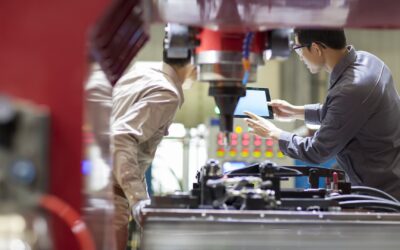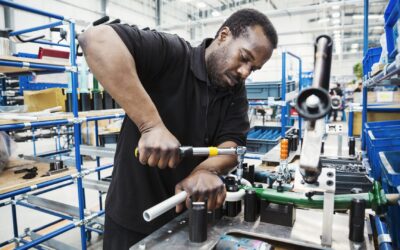The leader of advanced manufacturing at one of the world’s largest automotive suppliers once said to me, “I know someone’s a great design engineer when he’s present at the first shot.”
Packed into that simple sentence is one of the most powerful insights shaping the next-generation workspace for product development companies. Indeed, if you’re at a company where new ideas are critical to winning and sustaining industry leadership, the workspace that will help you get there should soon look nothing like the one you are working in now.
But back to that “first shot.”
The aforementioned company manufactures vehicle components by way of injection molding. So, the presence of the design engineer as that product comes out of the mold is certainly a signal of his enthusiasm and engagement in the original design. But more importantly, it means that he will be able to immediately assess the visual and tactile attributes of the product, revealing the quality, character, ease of assembly and many other factors going into the success of the product. He can then either approve its move into production or begin right there to provide design direction for more satisfying results.
The output of the first shot of plastic into the mold reveals much about the product’s potential success. Competitive positioning, client satisfaction, and program success could all be determined by that engineer’s first actions after that first shot.
But the design engineer in our story has been working at the waning end of a modern but traditional product development process. His digital design that produced the mold that produced that first shot of the product was probably the result of personal or team application of a topological approach yielding a good, but incremental improvement to the product. And it was an expensive process.
Now, the rapidly emerging technologies known as ‘generative design’ bring fundamental change to the organizations doing this product development work and the processes by which it is done.
Generative design, one of the foundational technologies of Industry 4.0, uses artificial intelligence to quickly produce more conceptual alternatives and more radically innovative products than the design engineer’s entire team previously could. Those alternatives are more rapidly, and less expensively, produced by additive manufacturing printers today rather than injection molds.
Beyond the numbers of alternatives produced, generative design also presents new challenges in the product design and development processes. In many cases, the algorithms driving the printers generate truly unusual and unconventional products. The uncanny or unexpectedly strange nature of some of those alternatives can be jarring. Moving products with non-intuitive appearance into further development and application will take an entirely different approach to stakeholder engagement.
In a recent article, McKinsey & Company points to the expectation that “smart algorithms won’t just lead to better products – they could redefine how product development is done.”
So, companies at the forefront of product design and development work, or wanting to be, may find it useful to step aside from conventional workplace planning and design terms. Instead, they might start considering five factors that begin to define what we’ve been calling The New Technical Workplace — Products, Presence, Proximity, Projects, and Platform.
Generative design and associated technologies will produce significantly larger numbers of product options over smaller amounts of time and at lower development cost. The workspace will come to resemble a design studio or maker’s workshop more so than an office or lab. Space allocations traditionally indexed to staff counts and departments may no longer be relevant or helpful as physical properties become more prolific. This is the factor of “Products.”
In many companies, the people engaged in the product development process currently sit in separate places. Employees engaged in product programs may be in different buildings, sites, or even countries, based on departmental or functional alignment. And in most cases, companies do not provide places for longer term occupancy by customers or vendors. But since the nature of generatively designed products may be unfamiliar or strange, their rapid assessment and acceptance will be integral to competitive success. Top product development organizations will attain and sustain leadership by finding a way to invite everybody who touches the product into a shared workspace where they can work together and interact dynamically. This is the factor of “Presence.”
The development, deployment and implementation of generative design technologies are still new. The product development organization will therefore need to consider ways to rapidly unglue and transfer tacit knowledge and make on-the-job learning a cultural differentiation. But the “Allen Curve” has been proven over and over — people who don’t sit in the same space just don’t interact with each other as significantly. The workspace of organizations will therefore become more agile and self-organizing to move know-how more quickly and efficiently. This then becomes the factor of “Proximity.”
Deployment of the organizational and operational benefits of generative design will move from parts to assemblies to fully integrated products. Departmental boundaries will dissolve as concepts for new products attract people to emerging programs. The entire workspace of leading organizations will be designed to support multiple ongoing efforts, some independent, some periodically integrating, some fast, and some slow. This is the principle of “Projects.”
Since achieving the significant benefits of time to market, cost, and product performance will be dependent on investment in tools, education, and cultural change, the workspace of leading organizations will need to be rich with resources. Older policies and practices that treated the workspace as a cost will now be reassessed as the workplace of industry leaders becomes occupied by a dynamic, agile, and continuously changing mix of talents, technologies, vendors, and equipment. This is what we consider the principle of “Platform.”
How companies respond to the power and potential in generative design and make a move into a more open and inclusive workspace will undoubtedly be a key strategic advantage in the very near future. In fact, a “new technical workplace,” adapted to these technologies and their organizational and operational changes, may ultimately enable the full promise of generative product design and development.
As an acquaintance recently observed, “Every industrial revolution is as much a story of how we organize work as it is of technological invention itself.”
Or, as we have always asked, since everything about work is changing, shouldn’t everything about the workspace change, too?
Jim Meredith is HED’s National Workplace Strategy Leader. As a consultant to many of America’s leading product development companies, Jim has planned and designed workspaces ranging from multi-million square foot automotive engineering centers to small startup labs supporting the speed and success of new enterprises. Jim is currently most active consulting with organizations moving “from hardware to software” and capturing big opportunities in Industry 4.0. HED seeks creative solutions that have a positive impact for its clients, the community, and the world, and has earned a reputation for excellence in all facets of the designed and built environment, including architecture, consulting, engineering, and planning services. The firm of over 450 staff serves clients in a broad range of markets from eight U.S. offices (Boston, Chicago, Dallas, Detroit, Los Angeles, San Diego, San Francisco, and Sacramento). They have been a member of Automation Alley for many years. See how HED advances your world at www.hed.design.




